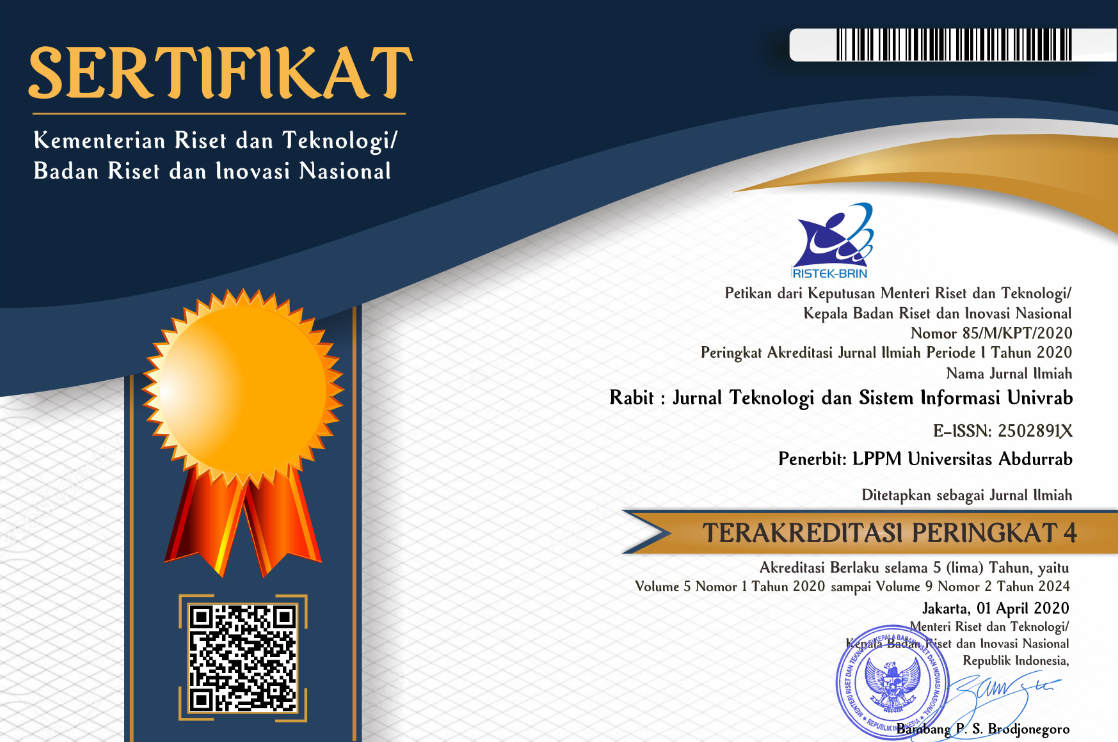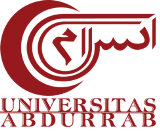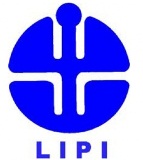ANALISIS DAN PERANCANGNAN ARSITEKTUR TEKNOLOGI PADA PERGURUAN TINGGI MENGGUNAKAN FRAMEWORK TOGAF
Abstract
In general, higher education is divided into two categories of benefits from the application of Information and Communication Technology (ICT). The first is referred to as core values and supporting values. The computer network at STMIK Amik Riau currently uses the Telkom Speedy Wireless Network provider in each building. Then each student is only given 1 account to access the Hotspot network on the STMIK Amik Riau campus which can only be used on 1 laptop that is registered and capacity that has been limited or shared by network operators. However, the use of Hotspots that students want to access is only found in a few places which if used are smooth. To overcome these problems a framework is needed, one of which is TOGAF. TOGAF is a framework that has a set of supporting tools for developing enterprise architectures. TOGAF is a method that can be adapted to all changes and needs during planning. The purpose of this research is to get the gaps in the existing technology architecture and then provide recommendations in the form of the proposed technology architecture so that the existing gaps can be repaired and can run well. The results of this study found that to improve service to students, 7 application modules were needed and the need for improvements to the existing network at STMIK Amik Riau.
References
E. Anih, “Modernisasi Pembelajaran Di Perguruan Tinggi Berbasis Teknologi Informasi Dan Komunikasi,” Judika (Jurnal Pendidikan UNSIKA), vol. 4, no. 2, pp. 185–196, 2016, doi: 10.35706/judika.v4i2.391.
A. Fitriansyah, Sukamto, and Elfizar, “Perencanaan Arsitektur Teknologi Informasi Menggunakan TOGAF Framework (Studi Kasus : Bagian Pelayanan pada Mahasiswa FMIPA Universitas Riau ),” Jurnal Politeknik Caltex Riau, vol. 3, no. 2, pp. 149–158, 2017.
M. K. Anam, N. Lizarti, and A. N. Ulfah, “Analisa Tingkat Kematangan Sistem Informasi Akademik STMIK Amik Riau Menggunakan ITIL V3 Domain Service Operation,” Fountain of Informatics Journal, vol. 4, no. 1, 2019, doi: 10.21111/fij.v4i1.2810.
H. Sujadi and A. Mutaqin, “Rancang Bangun Arsitektur Jaringan Komputer Teknologi Metropolitan Area Network (Man) Dengan Menggunakan Metode Network Development Life Cycle (NDLC) (Studi Kasus : Universitas Majalengka),” J-Ensitec, vol. 4, no. 01, 2017, doi: 10.31949/j-ensitec.v4i01.682.
A. A. A. Karim and I. Ali, “Perancangan Arsitektur Enterprise Perguruan Tinggi Menggunakan Togaf Adm (Studi Kasus Universitas Bumi Hijrah Maluku Utara),” Jurnal Ilmu komputer dan Bisnis, vol. 12, no. 2, pp. 59–73, 2021, doi: 10.47927/jikb.v12i2a.169.
L. Retnawati, “Perancangan Enterprise Architecture Menggunakan TOGAF di Universitas ABC,” Jurnal IPTEK, vol. 22, no. 1, p. 13, 2018, doi: 10.31284/j.iptek.2018.v22i1.221.
S. Husein and A. N. Fajar, “Design of a Cloud Based Information System for Education Institution using TOGAF ADM,” International Journal of Recent Technology and Engineering, vol. 8, no. 6, pp. 279–285, 2020, doi: 10.35940/ijrte.f7184.038620.
I. Maita, “Perencanaan Enterprise Architecture Dalam Pengelolaan Manajemen Teknologi Informasi Menggunakan TOGAF ADM,” Seminar Nasional Teknologi Informasi Komunikasi …, no. November, pp. 50–56, 2021.
M. K. Anam, T. Nasution, S. Erlinda, L. Efrizoni, and Susanti, “The Analysis and Optimization of Business Processes for Students in Higher Education Based on Togaf 9 . 2,” Scientific Journal of Informatics, vol. 8, no. 2, pp. 230–243, 2021, doi: 10.15294/sji.v8i1.29952.
M. Sidiq and I. D. Sumitra, “Strategic Information Systems Planning Using the Togaf Architecture Development Method,” in IOP Conference Series: Materials Science and Engineering, 2019. doi: 10.1088/1757-899X/662/2/022057.
T. Wahyuni, S. F. Rodiansyah, and A. A. Munandar, “Analisis Arsitektur Teknologi Informasi Pada Smk Negeri 1 Majalengka Menggunakan Framework Togaf,” Computatio: Journal of Computer Science and Information Systems, vol. 1, no. 1, pp. 68–80, 2017, doi: 10.24912/computatio.v1i1.242.
Sudirman, “Perancangan visi arsitektur togaf pada institusi pendidikan tinggi studi kasus: universitas bung karno,” Jurnal CKI On SPOT, vol. 10, no. 1, pp. 45–52, 2017.
M. D. S. Lubis, D. Hasannudin, J. Efendi, L. Wiljono, and M. Sufiani, “Membangun Router Pada Jaringan Komputer Menggunakan Ubuntu OS,” Jurnal Teknik Informatika Kaputama (JTIK), vol. 4, no. 2, pp. 111–125, 2020.
Y. Nurdiansyah, N. Pratama, M. I. Putra, and M. A. Sya’roni, “Analisis Perbandingan Metode Interior Gateway Protocol RIP Dengan OSPF Pada Jaringan MPLS-VPLS,” Informatics Journal, vol. 5, no. 2, pp. 49–56, 2020, doi: 10.19184/isj.v5i2.18668.
A. D. Riawati, M. Irfan, Khaeruddin, and A. Faruq, “High Availability Dynamic Sharding Database Server Dengan Metode Fail Over Dan Clustering,” Jurnal Manajemen Informatika & Sistem Informasi (MISI), vol. 5, no. 1, pp. 1–13, 2022, doi: 10.36595/misi.v5i1.416.
H. Sajati, Sudaryanto, and R. I. S. Nugroho, “Pengaruh Routing Protocol Switch Multilayer untuk Transfer Data Pada Jaringan Komputer,” Jurnal Nasional Teknologi Komputer, vol. 2, no. 2, pp. 81–91, 2022.
T. Aswin, P. Imansyah, F. T. P. W, J. Marpaung, and R. R. Yacoub, “Analisis Penerapan Access Point Dalam Rentang Frekuensi 2400 ─ 2500 Mhz Di Balmon Kelas Ii Pontianak,” JURNAL TEKNIK ELEKTRO UNIVERSITAS TANJUNGPURA, vol. 2, no. 1, pp. 1–12, 2021.

This work is licensed under a Creative Commons Attribution-NonCommercial-ShareAlike 4.0 International License.
Copyright Notice
The copyright of the received article shall be assigned to the publisher of the journal. The intended copyright includes the right to publish the article in various forms (including reprints). The journal maintains the publishing rights to published articles. Therefore, the author must submit a statement of the Copyright Transfer Agreement.*)
This work is licensed under a Creative Commons Attribution-NonCommercial-ShareAlike 4.0 International License.
In line with the license, authors and any users (readers and other researchers) are allowed to share and adapt the material only for non-commercial purposes. In addition, the material must be given appropriate credit, provided with a link to the license, and indicated if changes were made. If authors remix, transform or build upon the material, authors must distribute their contributions under the same license as the original.
Please find the rights and licenses in RABIT : Jurnal Teknologi dan Sistem Informasi Univrab. By submitting the article/manuscript of the article, the author(s) accept this policy.
1. License
The non-commercial use of the article will be governed by the Creative Commons Attribution license as currently displayed on Creative Commons Attribution-NonCommercial-ShareAlike 4.0 International License.
2. Author’s Warranties
The author warrants that the article is original, written by stated author(s), has not been published before, contains no unlawful statements, does not infringe the rights of others, is subject to copyright that is vested exclusively in the author and free of any third party rights, and that any necessary written permissions to quote from other sources have been obtained by the author(s).
3. User Rights
RABIT's spirit is to disseminate articles published are as free as possible. Under the Creative Commons license, RABIT permits users to copy, distribute, display, and perform the work for non-commercial purposes only. Users will also need to attribute authors and RABIT on distributing works in the journal.
4. Rights of Authors
Authors retain all their rights to the published works, such as (but not limited to) the following rights;
- Copyright and other proprietary rights relating to the article, such as patent rights,
- The right to use the substance of the article in own future works, including lectures and books,
- The right to reproduce the article for own purposes,
- The right to self-archive the article,
- The right to enter into separate, additional contractual arrangements for the non-exclusive distribution of the article's published version (e.g., post it to an institutional repository or publish it in a book), with an acknowledgment of its initial publication in this journal (RABIT : Jurnal Teknologi dan Sistem Informasi Univrab).
5. Co-Authorship
If the article was jointly prepared by other authors, any authors submitting the manuscript warrants that he/she has been authorized by all co-authors to be agreed on this copyright and license notice (agreement) on their behalf, and agrees to inform his/her co-authors of the terms of this policy. RABIT will not be held liable for anything that may arise due to the author(s) internal dispute. RABIT will only communicate with the corresponding author.
6. Royalties
This agreement entitles the author to no royalties or other fees. To such extent as legally permissible, the author waives his or her right to collect royalties relative to the article in respect of any use of the article by RABIT.
7. Miscellaneous
RABIT will publish the article (or have it published) in the journal if the article’s editorial process is successfully completed. RABIT's editors may modify the article to a style of punctuation, spelling, capitalization, referencing and usage that deems appropriate. The author acknowledges that the article may be published so that it will be publicly accessible and such access will be free of charge for the readers as mentioned in point 3.
 PDF (Bahasa Indonesia)
PDF (Bahasa Indonesia)
 Abstract views: 378
Abstract views: 378
 downloads: 348
downloads: 348

 :
:












